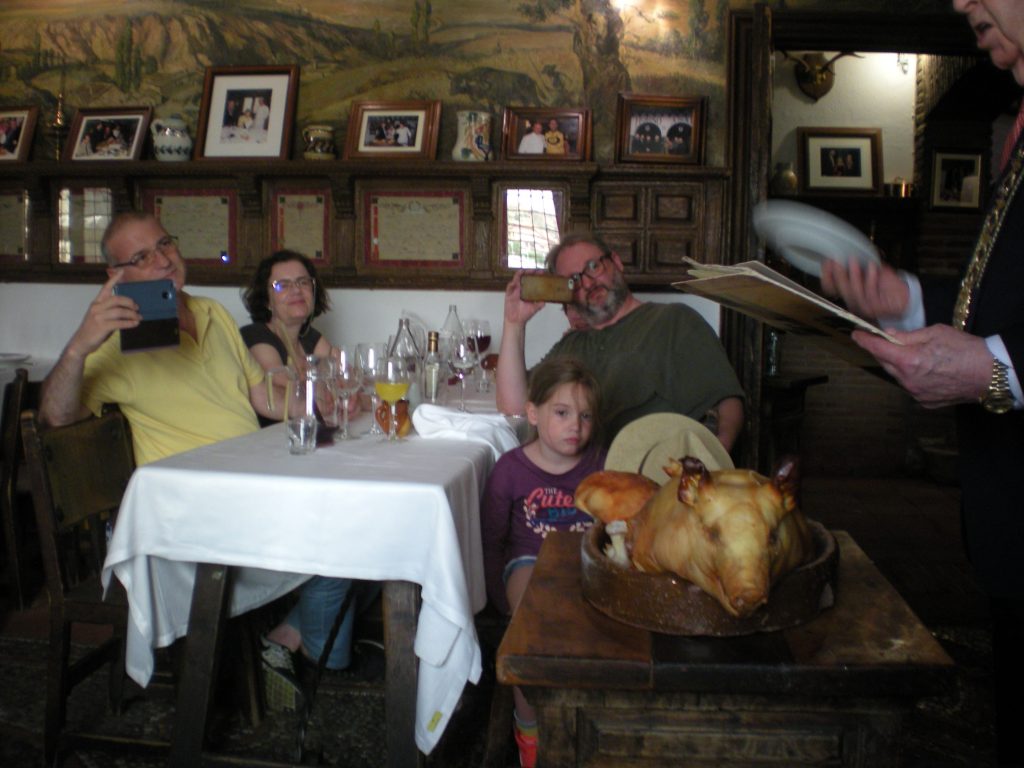UNITED STATES—Not Toledo, as promised for the mythical roasted rabbit… but Segovia. We departed mid-morning after a sluggish morning due to the cumulative effects of all the merrymaking. Midday hunger drove us out of Madrid.
We reached Segovia clustered around hills and ravines, full of tan buildings from the 1500s. A Roman aqueduct sweeps across one end of the town. It towerson two spans of arches, one very high and the second shorter. As astonishing as pyramids, but on a more compact scale, it’s amazing how the aqueducts’ keystones stay in place and are so intricately fitted, they have lasted through millenia.
This will be the day we get to see the rabbit, which has been a running joke. Throughout the long lifespan of this joke has figured the sense that you just cannot eat some animals you’ve loved, like cute and cuddly dogs, and of course rabbits. In the shadow of the aqueduct was a stout, monastic, that looks like it was a squat medieval barracks, with narrow casements and dark stone walls and arches in front. We arrive at the Meson de Candido, a dark lodge greeted by a young woman and quickly discover the specialty of the house is not conejo (rabbit), but cochinillo (suckling pig). There was the awful truth, and anybody who has read Charlotte’s Web will tell you that pigs can be pretty cute and cuddly.
We cross the threshold into this archival eatery, atop the last four steps a bar, devoid of anybody, with a boar’s head on the wall and a parchment, with the signatures of the Borbones over many years, Ranier, Sofia and the Prince of Asturias–a reminder of the monarchy that still is in Spain.
Beyond four more stone steps, cured hams hang in from the rafters. Tuxedoed waiters, ranging in age from tender to seasoned veterans, carry out their profession with deep solemn grace. They serve without being servile or fake. El Meson de Candido is very old school. In fact, the place got its schtick going around the early 1930s, though the visitor may suspect it has existed for centuries. The decor is movie-set baronial and that’s comforting; the windows look out onto the floating stone arches of the aqueduct.
I ordered judiones con orejas de cerdo (fava beans with pigs ears). The chewiness of the pig’s ears contrasted with the thick, tasty fava beans and Spanish chorrizo. Spanish chorrizo is dense and cured; it’s a whole other thing, just like there’s ham everywhere else, and then there’s ham in Spain.
There’s the guy in the dark blue suit and a chain around his neck, some real bling. This gold chain grants papal authority in the confines of Candidos. Many patrons stick around to take photos with him; he is surely the most photographed man in Segovia. He also sports a mesmerizing toupe.
While this personage sets up carefully as an executioner at the gallows, the piglet lies in wait on a block of wood. It looks baked and serene. For the delight of a whole American family, the ambassador of roast suckling pig invokes the solemn order of the cochinillo and the revered tradition which they, as patrons of the meson now become a part of. There’s no doubt he means every word of it.
Finally, when the ornate speech is done, the man takes a white plate, sets it on edge and cuts the piglet in half. It is so tender, the ceramic plate splits it down the middle from tail to snout. Then the majesty of Candidos breaks into a smile and says, “Enjoy.”
The man has been photographer with famous patrons including Harrison Ford and Richard Nixon. The big surprise at our table framed on the dark wood sill above the wainscotting: Cary Grant. I couldn’t have been more delighted. Patricio, Dave and Juan David got various parts of the pig, leg and breast, each the size of a small turkey, good and juicy, encased in a coating of brown crispy fat.
To be continued…






